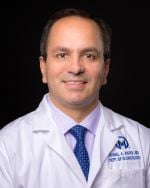Moffitt Specialists Share the Benefits of Education, Research and Rapid Treatment for Liver Cancer
According to the American Cancer Society, around 41,630 people will be newly diagnosed with primary liver cancer in the United States this year alone. Hepatocellular carcinoma (HCC) is the most common type of primary liver cancer, followed by cholangiocarcinoma.

Daniel Anaya, MD
“For many years, HCC has been one of the cancers that has continued to increase in incidence across the world, and it is one of the most frequent cancers leading to cancer-related mortality,” said Daniel Anaya, MD, a surgical oncologist and section head of the Hepatobiliary Program at Moffitt Cancer Center.
Common signs of liver cancer include stomach pain, unexplained weight loss, jaundice (yellowing of the skin and eyes), nausea, loss of appetite and general fatigue. Factors like cirrhosis (liver scarring), hepatitis viral infections (hepatitis B or C), fatty liver disease and inherited metabolic diseases increase the risk of liver cancer. However, maintaining a healthy weight, limiting alcohol intake, obtaining the hepatitis B vaccine and both screening and treating for hepatitis C infection can all decrease the risk of developing liver cancer.
The most common risk factor for liver cancer is chronic infection with the hepatitis B virus or hepatitis C virus. Research from The Centers for Disease Control and Prevention shows that 1 out of every 2 people with hepatitis B do not know they are infected. Hepatitis C infections also commonly go undetected due to the large number of asymptomatic cases. While there is a vaccine against hepatitis B, one does not currently exist for hepatitis C. However, there are effective treatments for hepatitis C infection. As such, the CDC guidelines recommend that every adult receives screening for both hepatitis B and C at least once in their lifetime.
Susan Vadaparampil, PhD, associate center director for Community Outreach, Engagement and Equity (COEE) at Moffitt, works to disseminate new cancer prevention and control innovations to the broader community. When it comes to liver cancer, Vadaparampil’s team seeks to educate both the public and health care providers about why screening for hepatitis infections should be a high priority. Against a backdrop of fairly new CDC hepatitis C screening guidelines, Vadaparampil utilizes educational workshops, printed materials and digital tools to increase awareness.
“In addition, the COEE office seeks to ensure that Moffitt responds to cancer trends in our community through rigorous research in prevention and early detection,” Vadaparampil said. “To address the increasing rates of liver cancer, Moffitt researchers in the Division of Population Science and the Center for Infection Immunization Research and Cancer have undertaken important studies demonstrating low hepatitis C screening rates at the local, state and national level. This data informed the design and ongoing testing of interventions in real-world health care settings, in partnership with community organizations.”

Susan Vadaparampil, PhD
"In 2020, the CDC updated hepatitis C screening guidelines to include all adults," Vadaparampil said. "However, we also know that new guidelines can take time to be adopted by the health care community. The Institute of Medicine’s “Crossing the Quality Chasm: A New Health System for the 21st Century” noted that it can take up to 17 years for a new innovation to fully be adopted into clinical practice. Education is critical to shortening this time frame for adoption."
Lifestyle changes, vaccination, screening and treating infection are key to prevention, and early diagnosis is important for those who have already developed cancer. Liver cancer is commonly diagnosed with a series of tests such as a physical exam, blood tests and imaging studies, often including liver biopsies. Once someone is diagnosed with liver cancer, receiving treatment right away is critical. Seeking treatment at a cancer center with oncological specialists who diagnose and treat this type of cancer regularly can eliminate a lengthy delay in treatment following a diagnosis.
To that end, Moffitt staffs its Gastrointestinal Oncology Department with a collaborative team of specialists, including gastroenterologists, medical oncologists, radiation oncologists, surgical oncologists, pathologists, interventional radiologists and supportive care experts. This team meets as a tumor board to collectively evaluate each patient. Using this collaborative approach, patients can receive multiple expert opinions in one place. “We do our multidisciplinary evaluations weekly and every patient is discussed so that when the patients come to Moffitt, everyone has reviewed the case, and we are ready to initiate treatment quickly and efficiently,” Anaya said.
Each liver cancer treatment plan is highly individualized. Treatment can include a combination of surgery, chemotherapy, interventional radiology and radiation therapy, among others. Moffitt patients have access to the latest treatment approaches through a robust portfolio of cutting-edge clinical trials, including new radiation therapies, chemotherapy drugs, immunotherapy and more. Moffitt researchers are also working to better understand the biology of liver cancer and develop new therapeutics and novel approaches to diet and physical activity, thereby improving patient outcomes.
“Moffitt stands out in seeking opportunities to provide exceptional treatment and clinical for liver cancer, but also in the integrated way our physicians and researchers partner to conduct research at Moffitt and in community settings,” Vadaparampil said. “We always strive to be good partners and keep a patient and community focus. Keeping these two groups at the forefront is what will help us achieve both parts of our mission focused on prevention and cure of cancer.”



